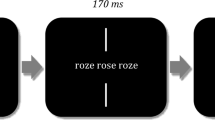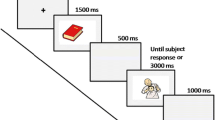Abstract
The current study investigated semantic, repetition, and phonological priming using heterographic homonyms (homophones) as stimuli in a lexical decision task. As in previous research, reliable semantic priming and repetition effects were found. In addition, the statistical additivity of these two effects was replicated using homophones as stimuli. Using homophones, a reliable phonological priming effect was found when 10-16 intervening trials were used. This effect was also statistically independent of semantic priming indicating the independence of the mechanisms responsible for semantic and phonological priming. The magnitude of the phonological priming effect was also significantly less than the magnitude of the repetition effect. This difference in effect magnitude was taken to indicate that the repetition of phonological information is not a primary contributor to the repetition effect.
Similar content being viewed by others
REFERENCES
Collins, A. M., & Loftus, E. F. (1975). A spreading-activation theory of semantic memory. Psychological Review, 82, 407-428.
Dannenbring, G. L., & Briand, K. (1982). Semantic priming and the word repetition effect in a lexical decision task. Canadian Journal of Psychology, 36, 435-444.
Davelaar, E., Coltheart, M., & Besner, D. (1978). Phonological recoding and lexical access. Memory and Cognition, 6, 391-402.
DenHeyer, K. (1985). On the nature of the proportion effect in semantic priming. Acta Psychologica, 60, 25-28.
DenHeyer, K., & Benson, K. (1988). Constraints on the additive relationship between semantic priming and word repetition and on the interactive relationship between semantic priming and stimulus clarity. Canadian Journal of Psychology, 42, 399-413.
DenHeyer, K., Briand, K., & Dannenbring, G. L. (1983). Strategic factors in a lexical decision task: Evidence for automatic and attention-driven processes. Memory and Cognition, 11, 374-381.
DenHeyer, K., Goring, A., & Dannenbring, G. L. (1985). Semantic priming and word repetition: The two effects are additive. Journal of Memory and Language, 24, 699-716.
Durgunoglu, A. Y. (1988). Repetition, semantic priming, and stimulus quality: Implications for the interactive-compensatory reading model. Journal of Experimental Psychology: Learning, Memory, and Cognition, 14, 590-603.
Evett, L. J., & Humphreys, G. W. (1981). The use of abstract graphemic information in lexical access. Quarterly Journal of Experimental Psychology, 33A, 325-350.
Feldman, L. B., & Moskovljevic, J. (1987). Repetition priming is not purely episodic in origin. Journal of Experimental Psychology: Learning, Memory, and Cognition, 13, 573-581.
Forster, K. I., & Davis, C. (1984). Repetition priming and frequency attenuation in lexical access. Journal of Experimental Psychology: Learning, Memory and Cognition, 10, 680-698.
Fowler, C. A., Napps, S. E., & Feldman, L. B. (1985). Relations among regular and irregular morphologically related words in the lexicon as revealed by repetition priming. Memory and Cognition, 13, 241-255.
Hanson, V. L., & Wilkenfeld, D. (1986). Morphophonology and lexical organization in deaf readers. Language and Speech, 28, 269-279.
Hillinger, M. L. (1980). Priming effects with phonologically similar words: The encoding-bias hypothesis reconsidered. Memory and Cognition, 8, 115-123.
Humphreys, G. W., Evett, L. J., & Taylor, D. E. (1982). Automatic phonological priming in visual word recognition. Memory and Cognition, 10, 576-590.
Jacoby, L. L. (1983). Remembering the data: Analyzing interactive processes in reading. Journal of Verbal Learning and Verbal Behavior, 22, 485-508.
Jacoby, L. L., & Dallas, M. (1981). On the relationship between autobiographical memory and perceptual learning. Journal of Experimental Psychology: General, 110, 306-340.
Jakimik, J., Cole, R. A., & Rudnicky, A. I. (1985). Sound and spelling in spoken word recognition. Journal of Memory and Language, 24, 165-178.
Kirsner, K., & Dunn, J. (1985). The perceptual record: A common factor in repetition priming and attribute retention. In M. I. Posner, & O. S. M. Marin (Eds.), Attention and performance XI (pp. 547-565). Hillsdale, NJ: Erlbaum.
Lima, S. D. (1987). Stem representation for prefixed words: Effects of compositionality of meaning. Paper presented at the meeting of the Midwestern Psychological Association, Chicago, May, 1987.
Mandler, G., Graf, P., & Kraft, D. (1986). Activation and elaboration effects in recognition and word priming. Quarterly Journal of Experimental Psychology, 38A, 645-662.
Martin, R. C., & Jensen, C. R. (1988). Phonological priming in the lexical decision task: A failure to replicate. Memory and Cognition, 16, 505-521.
Marohn, K. M., & Hochhaus, L. (1988). Different-case repetition still leads to perceptual blindness. Bulletin of the Psychonomic Society, 26, 29-31.
McNamara, T. P., & Gray, S. A. (1990). More evidence that mediated priming does not occur between semantic-phonological associates. Bulletin of the Psychonomic Society, 28, 199-200.
McQuade, D. V. (1983). Pre-lexical phonological recoding becomes automatic with stimulus repetitions. Language and Speech, 26, 393-405.
Meyer, D. E., & Schvaneveldt, R. W. (1971). Facilitation in recognizing pairs of words: Evidence of dependence between retrieval operations. Journal of Experimental Psychology, 90, 227-234.
Meyer, D. E., Schvaneveldt, R. W., & Ruddy, M. G. (1974). Functions of graphemic and phonological codes in visual word recognition. Memory and Cognition, 2, 309-321.
Neely, J. H. (1977). Semantic priming and retrieval from lexical memory: Roles of inhibitionless spreading activation and limited capacity attention. Journal of Experimental Psychology: General, 106, 226-254.
Overson, C., & Mandler, G. (1987). Indirect word priming in connected semantic and phonological contexts. Bulletin of the Psychonomic Society, 25, 229-232.
Peter, M., Lukatela, G., & Turvey, M. T. (1990). Phonological priming: Failure to replicate in the rapid naming task. Bulletin of the Psychonomic Society, 28, 389-392.
Schvaneveldt, R. W., & Meyer, D. E. (1973). Retrieval and comparison processes in semantic memory. In S. Kornblum (Ed.), Attention and performance IV. New York: Academic Press.
Squire, L. R., Shimamura, A. P., & Graf, P. (1985). Independence of recognition memory and priming effects: A neuropsychological analysis. Journal of Experimental Psychology: Learning, Memory and Cognition, 11, 37-44.
Stanners, R. F., Neisser, J. J., & Painton, S. (1979). Memory representations for prefixed words. Journal of Verbal Learning and Verbal Behavior, 18, 733-743.
Stanovich, K. E., West, R. F., & Feeman, D. J. (1981). A longitudinal study of sentence context effects in second grade children: Tests of an interactive compensatory model. Journal of Experimental Child Psychology, 32, 185-199.
Sternberg, S. (1969). Memory scanning: Mental processes revealed by reaction-time experiments. American Scientist, 57, 421-457.
Tulving, E. (1983). Elements of episodic memory. Oxford: Clarendom Press.
Tweedy, J. R., Lapinski, R. H., & Schvaneveldt, R. W. (1977). Semantic-context effects on word recognition: Influence of varying the proportion of items presented in an appropriate context. Memory and Cognition, 5, 84-89.
Wilding, J. (1986). Joint effects of semantic priming and repetition in a lexical decision task: Implications for a model of lexical access. Quarterly Journal of Experimental Psychology, 38A, 213-228.
Author information
Authors and Affiliations
Rights and permissions
About this article
Cite this article
Cronk, B.C. Phonological, Semantic, and Repetition Priming with Homophones. J Psycholinguist Res 30, 365–378 (2001). https://doi.org/10.1023/A:1010403523434
Issue Date:
DOI: https://doi.org/10.1023/A:1010403523434




